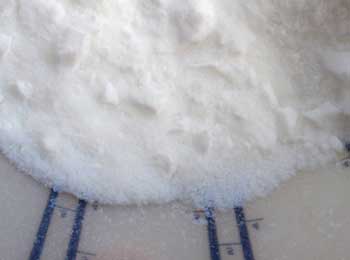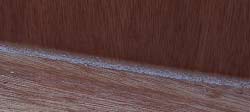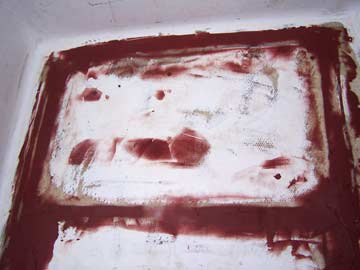
Fumed Silica also known as Colloidal Silica is a filler often used in epoxy
If you've ever though about building a boat or have actually built one using epoxy, you have most likely run across fumed silica, and wondered what it is and what it's characteristics are.
You've probably also wondered if it was dangerous, and what precautions should be used when handling it.
Another question about silica filler is when is it best to use and when is another filler a better choice.
Note that fumed silica, that is amorphous silica produced in the flame method from silica, is NOT the same as silica fume. Silica fume is a by-product of silicon metal production and is used mainly as a concrete additive where it adds strength and longevity to the concrete. Here is an article about Silica Fume. It is not used for boat-building.
So what is Fumed Silica

Silica in nature is usually found as the mineral quartz. Its chemical formula is SiO2. Most people are familiar with quartz as hexagonal crystals. These are often cut to be integrated in electronic components or as gemstones such as amethyst or citrine. There are also other forms of Silica classified by their crystalline form. Here is a brief article from the European Association of Industrial Silica Producers
If silica quartz sand is heated in an electric arc it vaporizes and condenses as tiny particles of amorphous silica. It is also produced by vaporizing silicon tetrachloride in a hot flame. This process is referred to flame pyrolysis.
These microscopic droplets of amorphous (non crystaline) silica aggregate into chainlike branched particles that further agglomerate into larger three dimensional particles.
The term "fumed" silica refer to the flame pyrolysis process. It is also called pyrogenic silica.
This is a quote from a manufacturer: "AEROSIL© fumed silica is a highly dispersed, amorphous, very pure silica which is produced by high temperature hydrolysis of silicon tetrachloride in an oxyhydrogen gas flame. The primary particles are spherical and free of pores. The primary particles in the flame interact to develop aggregates which join together reversibly to form agglomerates."
Fumed silica has an extremely high surface area, a very low density and a 3-d agglomerated configuration. This makes it a very powerful thickening agent.
Manufacturers speak of fumed silica as being thixotropic. It's a substance that becomes more fluid when agitated but quickly becomes more viscous when left to rest. Here is Wikipedia's article on thixotropy.
This property is useful for any substance that has to flow while being applied then stay where it has been placed, such as paint, ink or epoxy fillets.
Fumed silica is known also as amorphous silica. This means the internal structure is closer to glass, which has almost no internal crystalline structure, than to regular silica which has a well defined crystal structure.
Is Fumed Silica Dangerous
Amorphous silica, such as fumed silica (silica gel) is NOT associated with development of silicosis, but may cause irreversible lung damage in some cases, mainly sufficient exposure over a period of time. Here is an article on the health problems associated with fumed silica. The problems are associated with exposure to the very fine dust and are mostly liked with lung damage, but skin and eye irritations are possible.
The Center for Disease Control has this Guide for Amorphous Silica
I've been scouring the information available and what I figured out was that you should use a good quality dust mask while handling the silica filler. You should avoid disturbing it and letting it get airborne. Lung damage and irritations is possible and is linked to increased exposure. It is not going to burn a hole in your skin but can be irritating. It can also be unpleasant and damaging to the eyes.
The bottom line: If used carefully and with appropriate protection it is a safe material when used occasionally. Avoid breathing the dust, wear a dust mask and if you are particularly sensitive use a respirator designed for fine dust. Avoid contact with the skin and eyes. Note that this is what I think is appropriate. Do not take my word for this and do your own research. Be safe.
Hydrophilic or hydrophobic?
Fumed silica can be made to be wettable or can be made to repel water. For boat building you definitely want hydrophilic. Hydrophobic silica is used where you don't want water to be incorporated. Among many uses, it is used to coat fly-fishing flies so that they float and don't get waterlogged.
Some uses of Fumed Silica
Because of its very large surface area in relation to its weight, it is often used as a thickening agent. It is a common component of paints, inks and coatings. It allows the coatings and inks to flow on then thickens more and stops sagging. It is also used as a anti-settling additive and it helps powders flow better. At high temperatures it is an effective insulator.
Here is a factsheet about uses for fumed silica, pdf
Why is it added to epoxy in boat building?
Silica in epoxy used as glue
Epoxy is often used as a glue. By itself, it is quite runny and will not stay in place unless the joint is very accurate with no gap. By itself epoxy is not a particularly good gap filler. When the epoxy is thickened all this changes. The epoxy becomes a very good gap filler squeezing into all the corners and slight imperfections and stays in place. Not only is it a very forgiving glue but it is STRONG. When you try to take apart properly glued pieces, the wood will usually break before the glued joint.
Epoxy joints are best clamped with moderate pressure. If a joint is glued with excessive force the epoxy will squeeze out of the joint and it will be starved of glue and not be a strong joint.
Another factor that can starve a joint and weaken the bond is if the wood absorbs the epoxy and not enough is left to glue the wood. For this reason it is not a bad idea to paint on a layer of unthickened epoxy onto the surfaces to allow the wood to absorb the epoxy and to then apply the thickened glue before joining and clamping.
How much to thicken depends on the situation. Generally a mixture that flows very slowly off the spoon will work. The goal is to put the thickened glue on, clamp it and have a bit of squeeze out so that the glue flow into any recess it needs to fill but does not flow out of the joint.
Silica has a wonderful property, it is runnier as you mix it then it thickens when allowed to sit for a bit. It is Thixotropic.
Wood flour is often added to the Silica and Epoxy mixture to improve the texture and modify the colour to make it less conspicuous. Avoid very coarse sawdust for this.
Although wood flour is not as strong as silica, the joint is usually stronger than the surrounding wood and the slightly weakened joint has no effect on the strength of the construction. Mixtures of epoxy with less strong fillers such as microspheres are not strong and should not be used in structural applications. They are great for fairing.
Silica in filleting mixture

A fillet is a bead of epoxy mixture placed at the junction of 2 pieces of wood used to considerably increase the strength of a joint. Many joints made in stitch and glue boatbuilding are essentially butt joints. There is not a lot of surface area to strengthen the joint so a fillet is used. In this case the fillet is fully structural and needs to be as strong as possible as it provides most of the holding power. Bulkheads are often held in place by fillets with no additional strengthening from screws or nails.
Typically the bulkhead is stitched onto the hull with copper wire placed at short intervals along the joint. A few spots of glue are placed to hold the parts together. Once these spots have set the copper stitches are either removed or ground down and a fillet is applied over the full length of the joint providing the necessary strength.
Fillets can join up to 10mm plywood with no trouble. A radius of half to three quarter inch will make a strong bond. If you need to join thicker material either the radius has to be increased or a backing piece of wood would be better. It is possible to join only with fillets but they can become quite large and this means extra weight and extra expense as epoxy is not a cheap material.
If the fillet is being used to improve appearances such as where the cabin joins the top of a deck and it is desirable to have a nice large radius, then increasing the amount of lighter (and not so strong) fillers is acceptable.
There are several lighter fillers such as micro spheres which provide bulk and ease of sanding but are not so strong as silica. These are sometimes added to silica thickened epoxy to reduce weight and improve sanding ability.
Epoxy used for fillets should be slightly thicker than for glueing. Most people describe it as the thickness of peanut butter of mayonnaise. It should flow from your bag without sagging but make a smooth bead that you can then shape with a spoon, shaped piece of wood, or special plastic fillet shaper.
Most people apply a fillet by squeezing out a bead from a strong plastic bag with a corner cut out.
Silica thickened epoxy is sometimes used to help fill fiberglass cloth weave.

Silica and other fillers is added to epoxy to help fill weave of fiberglass faster than with only epoxy. Note that it is not completely transparent and will show if used on a surface that is to be finished bright, particularly when the light hits it in a specific angle and a haze becomes visible.
Since the cloth provides the strength, the filler can be a less strong material and it is not unusual to prefer a lighter material such as microbeads as seen here.
One advantage to using epoxy as a weave filler is that it makes a harder surface more resistant to abrasion, but more difficult to sand and fair.
When used as the only filler, Silica is white. To modify the colour and flowing ability, wood flour is often added. Adding wood flour also makes the hardened epoxy easier to sand than epoxy with only silica added.
email me if you find mistakes, I'll fix them and we'll all benefit: ChristineFumed Silica
AEROSIL® is a brand of fumed silica which is marketed for many uses.
Here is a link to the technical page for an AEROSIL thickener for epoxy silica formulation
Cab-O-Sil is produced by Cabot and often used in boatbuilding
Product information sheet from Sigma on Fumed Silica It's a PDF format.
Some suppliers of Fumed silica for Boat building
West System colloidal silica, quart:
Cab-O-Sil 5 quartz from Fiberglass Coatings:
Bateau2.com sells boatbuilding supplies including several fillers and thickeners:
Bateau supplies
Fiber Glast sell many different kinds of filler included fumed silica
Small Print
I don't claim to be an expert. I'm not an engineer. IF you want to build a boat, take proper precautions. This information is for general knowledge only. Otherwise have fun.